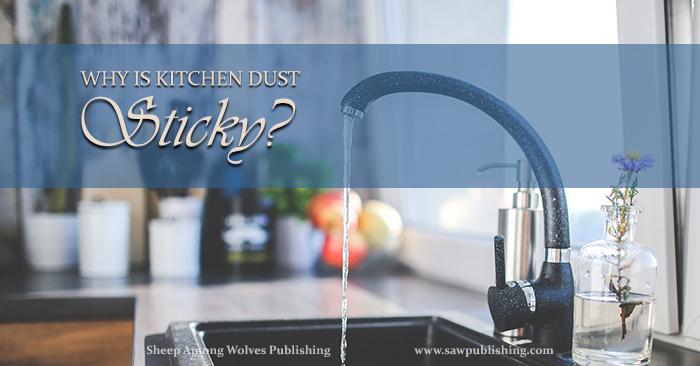Why Is Kitchen Dust Sticky?
 I used to keep my teacup collection on top of the kitchen cupboards. I don’t anymore. I used to have to thoroughly wash each teacup before I used it—now I dust them out with a towel.
I used to keep my teacup collection on top of the kitchen cupboards. I don’t anymore. I used to have to thoroughly wash each teacup before I used it—now I dust them out with a towel.
These statements may sound somewhat disconnected, but they really aren’t. The reason that I don’t keep my teacups on top of the kitchen cupboards is because when I did they all got covered in a layer of sticky dust that was both annoying and unappetizing. So, when we moved a couple of years ago, we made room for the teacup collection inside one of the cupboards instead. And I haven’t had to wash sticky dust off of my teacups since.
But even though I solved the problem, I never answered the question. Why do things in the kitchen get covered in sticky dust?
What’s Different About the Kitchen?
The perplexing side about this whole problem, is that stickiness is not the usual nature of dust—the dust in my bedroom hasn’t the slightest residue of stickiness. On the contrary, it’s very dry. But there are several differences between dust in the kitchen and dust in the rest of the house:
- Dusty items in the kitchen feel sticky to the touch.
- This sticky dust can’t be wiped off with an ordinary dust cloth, it has to be washed off instead.
- The stickiness isn’t related to the quantity of dust—even a small amount is sticky.
The dust of the kitchen is different from the rest of the house, and so are the functions of the kitchen:
- The kitchen is the only room in the typical house where cooking is done.
- The processes of cooking, especially on the stove top, introduce steam, vapours, and sometimes (dare we add) smoke to the kitchen environment.
- Even with the best ventilation systems, the moisture and odors created by the cooking process spread throughout the kitchen when cooking is going on.
So, we have a difference in conditions and a difference in results, which makes sense when we think about it. The question becomes, what is it about these conditions which are producing these results?
Why Does the Dust Get Sticky?
The answer to this question comes from Olive Hyde Foster in her book, Housekeeping for Little Girls:
“In the kitchen you will probably notice that a layer of greasy dust collects very quickly on everything. This is because in cooking part of the solid matter is carried off with the steam and settles everywhere, catching and holding the dust.”
So there it is. It is actually a residue of our food during cooking that lands on things in the kitchen and traps the dust in its stickiness! Kind of gross, isn’t it? The sticky dust in our kitchen is the by-product of breakfast, lunch and supper 365 days a year.
What Can You Do About It?
 It may be kind of frustrating to realize that there is really nothing we can do to solve this problem. (Even while the homeschooler in some of you may be meditating an impromptu science lesson!) We could stop cooking, of course, or maybe switch to “microwave only,” and see if that helps, but the reality of the matter is that we aren’t going to do that. We’re going to keep cooking in our kitchen, and as long as we do that, there’s going to be sticky dust. There really isn’t anything we can do about that.
It may be kind of frustrating to realize that there is really nothing we can do to solve this problem. (Even while the homeschooler in some of you may be meditating an impromptu science lesson!) We could stop cooking, of course, or maybe switch to “microwave only,” and see if that helps, but the reality of the matter is that we aren’t going to do that. We’re going to keep cooking in our kitchen, and as long as we do that, there’s going to be sticky dust. There really isn’t anything we can do about that.
But, maybe, on second thought, that statement isn’t true. There’s nothing we can do to prevent sticky dust, I grant you, but there are two things that we can do to remove it after it settles.
1) Use the Right Tools. Trying to solve a problem with the wrong solution only creates extra work and unnecessary frustration. Cleaning sticky dust with a duster will only make the duster sticky, without getting the grease off of the article being dusted. Fortunately, Olive Hyde Foster gives instructions for how to treat this kind of dust in a more effective way:
“This [dust] is hard to get off, and will probably require scrubbing with warm water, good soap, and a little borax or ammonia to cut the grease. Wash only a small surface at a time, so that the alkali in the soap will not injure the paint or varnish, rinse with clear water, and wipe perfectly dry.”
2) Use the Right Attitude. A bad attitude isn’t something adults struggle with, right? Well, maybe we all feel a little temptation to grumble when we find out there isn’t an “easy” solution. But rather than focusing on the disappointing news that sticky dust in the kitchen will pretty much always call for the administration of some elbow-grease, let’s look on this challenge which we all face as an opportunity to tackle an ongoing job in the best way. As the author of Housekeeping for Little Girls states:
“Even a child, I believe, feels the pleasure of going into a fresh, clean kitchen, and I want all my . . . housekeepers to learn how to keep things nice.”
After all, the dust in the other rooms of the house doesn’t clean itself either. Nor does the laundry fold itself, or the dishes magically get washed at the wave of a hand. Keeping our homes nice takes work, but it’s a whole lot easier when we know what to do for each problem.
We have the opportunity, the resources, and the privilege of being industrious homemakers. Let’s embrace that calling with joy!
Keeping Your Eyes Open
I used to think that the layer of sticky dust coating all my teacups was mostly because I didn’t clean above the cupboards often enough. I blamed myself, looked for no solution (except storing the teacups elsewhere) and had no way of coping with the stickiness I so disliked.
Aren’t we all like that sometimes? Instead of looking for the reason why things happen, we blame ourselves and—do nothing at all about it!
Even if you haven’t been particularly bothered by the question of sticky dust in your kitchen, the principle of noticing and asking questions about the problems we encounter in our daily homemaking can help us to cultivate an interest in our homes. The best homemakers are those who have their head and heart invested in their work, in addition to their hands.
Not every homemaking job will be “fun” to every homemaker, but we owe it to ourselves and our families to make homemaking our interest as well as our duty.
“And whatsoever ye do, do it heartily, as to the Lord, and not unto men;” – Colossians 3:23
Are you looking for further encouragement to be a godly keeper at home? Our Timeless Tips from Homemakers of the Past series is a wonderful resource for tips and tricks discovered by previous generations for fulfilling home duties.
You might also enjoy:

Isaac Watts’ four reasons to teach your children hymns challenge you to make use of his powerful tool for training the next generation.

Just starting out on your homeschooling journey? My Kitchen, My Classroom by Jennifer Bly gives a wonderful introduction to teaching at home.

Are you looking for a Christian course that will teach your high school student to write poetry? Check out our FREE 10 Weeks to Writing Good and Great Poetry.

